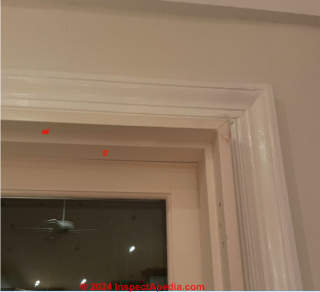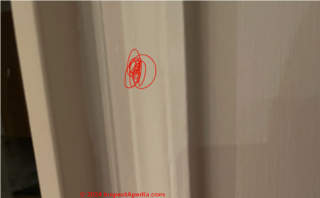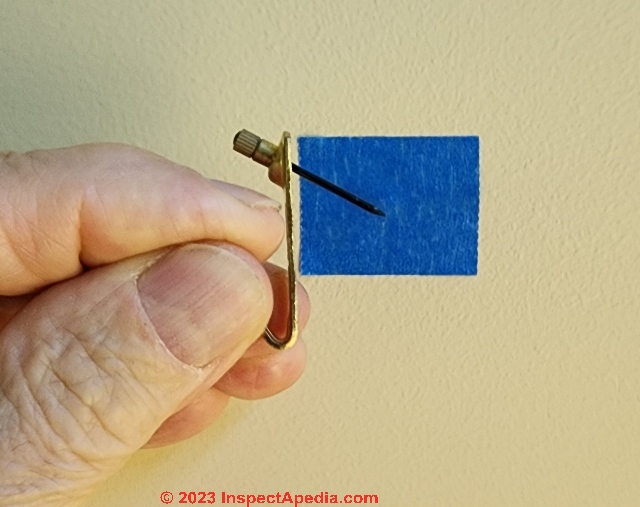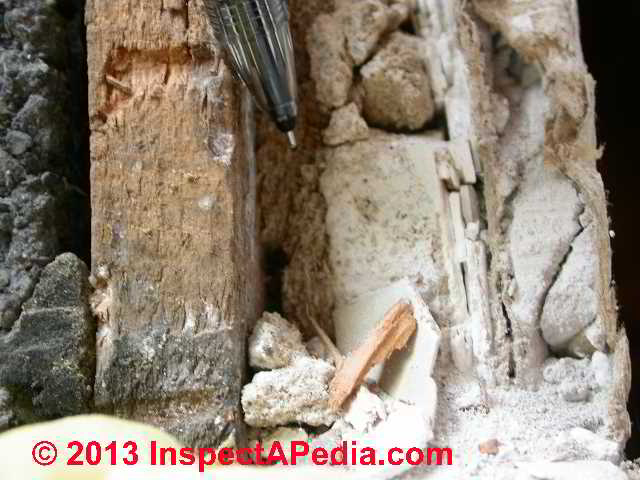 Asbestos Content in Drywall & Joint Compound (drywall mud)
Asbestos Content in Drywall & Joint Compound (drywall mud)
What drywall or drywall products & finish systems contain asbestos?
Chrysotile & amphibole asbestos hazards
- POST a QUESTION or COMMENT about the level of asbestos found in drywall on walls & ceilings.
Does drywall or "sheetrock" contain asbestos?
Is it safe to drill, drive a screw, or hammer a nail into asbestos-suspect drywall?
This article explains where asbestos is likely to be found in gypsum board or drywall systems, particularly in the taping compound and in skim coats using drywall "mud" that contained asbestos.
Asbestos is safe and legal to remain in homes or public buildings as long as the asbestos materials are in good condition and the asbestos can not be released into the air. - US EPA & Others.
InspectAPedia tolerates no conflicts of interest. We have no relationship with advertisers, products, or services discussed at this website.
- Daniel Friedman, Publisher/Editor/Author - See WHO ARE WE?
Asbestos content in Drywall, wallboard or "Sheetrock" or gypsum board & in joint compound
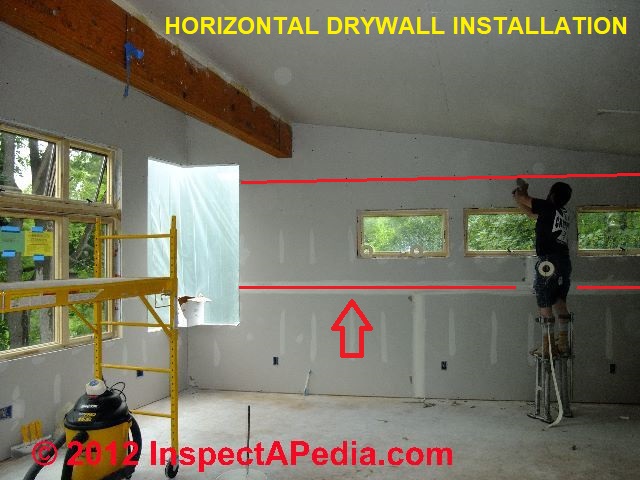 Article Contents
Article Contents
- ASBESTOS HAZARDS In DRYWALL - Introduction
- ASBESTOS CONTENT IN DRYWALL MUD
- CHANCES THAT DRYWALL MUD / JOINT COMPOUND CONTAINS ASBESTOS
- CHANCES that DRYWALL or "Sheetrock" CONTAINS ASBESTOS
- HOW MUCH ASBESTOS IS / WAS in JOINT COMPOUND (DRYWALL "MUD")
Photo: showing typical joint lines when drywall is run horizontally during installation at the author's offices. If you are testing drywall for asbestos be sure that the drywall mud is tested as well. For that purpose it's useful to know where the mud or joint compound was used most heavily - at joints, corners, and at the ceiling-wall juncture.
[Click to enlarge any image]
Introduction to Asbestos Hazards in Drywall
Modern drywall and taping compound do not contain asbestos. However that was not always the case, as we detail here.
If drywall or gypsum board or "Sheetrock®" was installed in your building in North America between the late 1920s and 1980, it is possible that the drywall itself or more-likely the joint compound used on the drywall contains asbestos, primarily chrysotile asbestos.
Not all drywall sold during those years contains asbestos, and it's less commonly found in residential applications.
Keep in mind that asbestos is not like a "radioactive" substance. It is not harmful if it is covered and /or otherwise left undisturbed. Avoid creating a dusty mess.
Excerpting from our master list of asbestos-containing products, ASBESTOS LIST of PRODUCTS we report the following example of evidence of the use of asbestos in drywall or gypsum board.
Principally you'll find that references to asbestos in a drywall system focus on asbestos that was contained in joint compound or in some paint or spray products such as "popcorn ceiling paint" that may have been sprayed on drywall ceilings.
Keep in mind that asbestos-containing joint compound may have been applied not only up to 18" wide over drywall joints but also in patches, repairs, around penetrations or fixtures, and in some buildings as a skim coat over an entire wall or ceiling surface.
Drywall systems that may contain asbestos - at least in finishes, taping joint compounds, skim coats, or in systems that applied plaster over gypsum board date from about 1910 through the early 1980's in North America (1982 in Canada).
Taping drywall joints dates from as early as the 1920's. Asbestos-use in plaster overlaps this period.
In Canada most provinces classify the asbestos hazard associated with drywall removal as a "low risk or type 1" hazard requiring normal dust control. (Pinchin 2011). The U.S. advice is typified by the U.S. EPA quotes included in the citation below.
For a complete list of all companies who sold products containing asbestos, including those selling ceiling & wall coverings, drywall, rock lath, gypsum board, paints & coatings that contained asbestos,
see ASBESTOS PRODUCING COMPANIES & TRUSTS
Asbestos Content in Joint Compound or Drywall "Mud"
 Drywall or "joint compound" asbestos content: on older buildings may contain asbestos fibers. Asbestos was [probably] universally used in drywall joint compound prior to the early 1980's.
Drywall or "joint compound" asbestos content: on older buildings may contain asbestos fibers. Asbestos was [probably] universally used in drywall joint compound prior to the early 1980's.
In joint compound the asbestos content varied but typically was between 3-6%.
Even if the gypsum board itself did not contain asbestos this means that by weight the asbestos content of the wall system was about 0.25%. (Redmond 2011), "Sheetrock mud" is a synonym for drywall compound or joint compound that before 1978 may have contained asbestos fibers.
Question: what kinds of asbestos were used in drywall joint compound: Chrysotile or Amphibole?
2016/06/14, Anonymous said:
What variety of asbestos was used in drywall, Crysotile or amphibole?
Reply: Primarily Chrisotile Asbestos but Amphibole Asbestos may also be present in drywall compound
Both Chrysotile and Amphibole asbestos were the first and second most-widely used forms of asbestos used in many building products. In drywall compound from what I've found, Crysotile was used, but Amphibole was also present.
Until the mid–1970s, however, some joint compounds contained chrysotile asbestos as a filler in the range of 5–15% by weight.(1,5) Amphibole mineral fragments, most commonly in the tremolite series, were reported as sometimes present in concentrations of 2–12%, likely as a contaminant in the chrysotile or talc, ...
... Published historical data on amphibole mineral contaminants in joint compound, however, do not provide sufficient information to conclude that the minerals were amphibole asbestiform fibers and not elongate tremolite cleavage fragments.
Until the characteristics of the mineral being studied are clearly determined, there will be confusion as to the biological effect of asbestos and non-asbestos amphibole minerals.
Exposure monitoring in the 1970s reported peak asbestos fiber concentrations (as total fibers) in excess of the then Threshold Limit Value (TLV) of 5 fibers longer than 5 μm per cc (5 f/cc) during the mixing of dry-mix joint compound with water,(9) sanding of joint compound, and clean-up activities. - (Boelter 2015)
And
Asbestos minerals are divided into two major groups: Serpentine asbestos and amphibole asbestos. Serpentine asbestos includes the mineral chrysotile, which has long, curly fibers that can be woven.
Chrysotile asbestos is the form that has been used most widely in commercial applications.
Amphibole asbestos includes the minerals actinolite, tremolite, anthophyllite, crocidolite, and amosite. Amphibole asbestos has straight, needle-like fibers that are more brittle than those of serpentine asbestos and are more limited in their ability to be fabricated. - (US NIH Cancer Institute 2022)
Diagnostic Questions Help Guess at Risk of Asbestos in Gypsum Board / Drywall or "Sheetrock®"
If you can establish the date of the home's construction that gives a floor under the "does my drywall contain asbestos" question - particularly when you add country and city of installation.
1. Check drywall back and edges for identifying stamps,
dates, standards bar-codes. Sometimes we get lucky in dating drywall from stamps and labels.
ASTM Standard C36 Standard Specification for Gypsum Wallboard (Withdrawn 2005) was replaced by Active Standard ASTM C1396 / C1396M - but that doesn't give us an "earliest" date and had versions published in 1997 - 2003.
Similarly the sticker doesn't give an "earliest" date for ASTM C1396 / C1396M-17, Standard Specification for Gypsum Board, ASTM International, West Conshohocken, PA, 2017, www.astm.org
2. Location of drywall installation:
What are the country and city and date of construction of your home
3. Type of drywall installation:
is the drywall installed in an area where fire-resistant drywall is likely to have been used such as in a boiler room or on a wall between a garage and occupied living space?
4. Age: date of drywall installation or dates of building:
When was the specific drywall installed? Was it from original construction or from a later renovation or addition?
5. Drywall manufacturer:
Even without finding stamps, stickers, or codes that help date a drywall or gypsum board product, if a stamp identifies the manufacturer (as most do) and if you know the ages or dates of the drywall you can often contact the company to ascertain if they ever used asbestos in their gypsum board products and if so during what years was that product manufactured.
Also see ASBESTOS PRODUCING COMPANIES & TRUSTS where we list companies known to have used asbestos in various products and where we give dates of that use.
In your case the Canadian company CGC is a major manufacturer of gypsum board products as well as acoustical ceilings. The company has locations around the world. CGC does appear in our list of known asbestos users. USG and probably CSG products known to contain asbestos were produced between about 1920 and 1978. Contact the company at:
- CGC Inc. Corporate Office 350 Burnhamthorpe Road West 5th Floor Mississauga, Ontario L5B 3J1 Tel. (905) 803-5600 Fax (905) 803-5688 Toll free: 1-800-565-6607 Customer Service: Toll Free#: 1-800-387-2690
What is the Actual Level of Asbestos Found in Joint Compound or Drywall Systems?
Drywall or "joint compound" asbestos content: on older buildings may contain asbestos fibers. Asbestos was universally used in drywall joint compound prior to the early 1980's. In joint compound the asbestos content varied but typically was between 3-6%.
Plaster disclosure research often helps identify products that contained asbestos even though some disclosures do not give percentages of asbestos in the product mix.
For example, Kaiser Gypsum Company, Inc. produced joint compound in at least three product lines that may have contained asbestos including Kaiser Gypsum Joint Compound and Kaiser One-Day Joint Compound produced between 1953 and 1975, Kaiser Dual Purpose Joint Compound (undated) and Kaiser "Hard Top" insulating cement produced between 1964 and 1972.
Refractory cement used in heating boilers and possibly in some fireplaces in the form of a cementious plaster may also have contained asbestos.\
Note that many of these drywall and joint compound producers also produced products specifically identified as "asbestos free", such as US Gypsum's asbestos-free joint compound patented in 1975 and cited below.
Even if the gypsum board itself did not contain asbestos this means that by weight the asbestos content of the wall system was about 0.25%. (Redmond 2011), "Sheetrock mud" is a synonym for drywall compound or joint compound that before 1978 may have contained asbestos fibers.
- Asbestos in Joint Compound, Bondex:
[Note that asbestos was commonly used in other brands of joint compound as well.]
Bondex manufactured a joint compound that was commonly used on construction sites during the installation of drywall. From 1961 to 1977, Bondex joint compound contained asbestos.
- retrieved 15 June 2015 original source: www.courts.mo.gov/file.jsp?id=54841 [LOIS J. WAGNER, ROBIN G. ) WAGNER and WENDE L. WAGNER, ) Individually and as Wrongful Death ) Beneficiaries of ROBERT WAGNER, ) ) Appellant-Respondent, ) ) WD72474 (Consolidated with WD72482 v. ) and WD72619) ) BONDEX INTERNATIONAL, INC., and ) Opinion filed: June 19, 2012 SIMPSON TIMBER COMPANY, ) ) Respondent-Appellant, ) ) CONWED CORPORATION, ) ) Defendant. ) APPEAL FROM THE CIRCUIT COURT OF CLAY COUNTY, MISSOURI The Honorable Kathryn E. Davis, Judge Before Division Four: Lisa White Hardwick, Chief Judge, Presiding, Joseph M. Ellis, Judge and Victor C. Howard, Judge] - ASBESTOS CONTAINING COMPOUND in WALLBOARD [PDF] (2000) Washington State Department of Labor & Industries, WISHA, WISHA Policy & Technical Services at P.O. Box 44648 USA, Tel: (360)902-5503. DOSH Website (www.lni.wa.gov/Safety-health/). - retrieved 2021/03/24 original source: www.lni.wa.gov/dA/fe0b92a166/WRD2330.pdf
Notes from this document:
The level of asbestos in drywall ranges from none to just a few percent
and
the level of asbestos used in joint compound was also zero to about 5 percent by weight.
- Brorby, G. P., P. J. Sheehan, D. W. Berman, J. F. Greene, and S. E. Holm. "Re-creation of historical chrysotile-containing joint compounds." Inhalation toxicology 20, no. 11 (2008): 1043-1053.
Abstract
Chrysotile-containing joint compound was commonly used in construction of residential and commercial buildings through the mid 1970s; however, these products have not been manufactured in the United States for more than 30 years. Little is known about actual human exposures to chrysotile fibers that may have resulted from use of chrysotile-containing joint compounds, because few exposure and no health-effects studies have been conducted specifically with these products.
Because limited amounts of historical joint compounds are available (and the stability or representativeness of aged products is suspect), it is currently impossible to conduct meaningful studies to better understand the nature and magnitude of potential exposures to chrysotile that may have been associated with historical use of these products.
Therefore, to support specific exposure and toxicology research activities, two types of chrysotile-containing joint compounds were produced according to original formulations from the late 1960s.
To the extent possible, ingredients were the same as those used originally, with many obtained from the original suppliers.
The chrysotile used historically in these products was primarily Grade 7RF9 from the Philip Carey mine.
Because this mine is closed, a suitable alternate was identified by comparing the sizes and mineral composition of asbestos structures in a sample of what has been represented to be historical joint compound (all of which were chrysotile) to those in samples of three currently commercially available Grade 7 chrysotile products.
The re-created materials generally conformed to original product specifications (e.g. viscosity, workability, crack resistance), indicating that these materials are sufficiently representative of the original products to support research activities. - Dahlgren, James, and Trevor Peckham. "Mesothelioma associated with use of drywall joint compound: a case series and review of literature." International journal of occupational and environmental health 18, no. 4 (2012): 337-343
- Earl, Maynard, and Mitchell P. Ptasienski. "Substantially dry joint compound comprising calcium sulfate, polyvinyl acetate and starch." U.S. Patent 3,297,601, issued January 10, 1967. Original assignee, United States Gypsum Co.
Excerpt: Casein or certain refined soya proteins solubilized in water by alkaline materials are used extensively for this purpose.
When properly blended with fillers such as ground asbestos, mica, clays and limestone and perhaps preservatives and thickening agents such as natural gums, a joint compound is obtained which is capable of binding the joint tapes in place and providing a smooth surface. - Henkel, William W. "Method of plastering wall surfaces and joint sealing compound used therein." U.S. Patent 3,382,119, issued May 7, 1968. Original assignee: Valspar Corporation, a North American manufacturer of paints & coatings since 1806.
Excerpt: The joint compound was made up in a quantity of 2500 /2 lbs. as follows (dry basis): 2100 lbs. No. 3 Whiting calcium carbonate obtained from Thomson Weinman & Co., 180 lbs. Mineralite M260 mica from Mineralite Sales Corp, 98 lbs. of #7RF-l0 asbestos from Carey- Canadian Mines Ltd. and 25 lbs. of Mistron Monomix Talc from Sierra Talc Co., were mixed to provide the filler. 57 lbs.
Gelva Powder 702 (polyvinyl acetate) from Shawinigan Resin Corp, and 19 lbs. #2030 BP (polyvinyl alcohol) from Shawinigan were mixed to provide the binder. The adjuvant included 14 lbs. of #4000 HG- 65 Methocel obtained from Dow Chemical Co., and 5% lbs. potassium tripolyphosphate from Kraft Chemical and 1% lbs. anhydrous sodium acetate was obtained from Kraft Chemical Co. ...
I find that to achieve the advantageous integration of the joint cement with the gypsum panels, the characteristic of the filler should follow that of the optimum formulation set forth above, particularly relative to mica and asbestos.
This is helpful not only in the plastering procedure set forth in the above example, but, also in the dry wall operation where crackless joints are mandatory. For the asbestos, I find the fiber should be of such a length (dry) as to have slightly under 50% retained on a 35 mesh Tyler sieve.
The actual distribution of asbestos fibers in this drywall product was as given in Table I below:
Table I Mesh size Percentage retained 14 Trace 28 2.0 35 40.0 100 35.0 200 1.5 Pan 16.5
The bulk density of the asbestos fibers was about 10.5 lbs. per cubic foot and the wet volume (settling rate for fibers of a given weight and a given quantity of water) was two hours for 10 grams in 500 cc. of water and four hours for 50 grams in 2000 cc. of water.
The absorbability of the asbestos was determined in a number of ways to characterize the optimum formulation. - Raffaelli, Albert F., and Paul W. Tillisch. "Joint structure for plasterboard." U.S. Patent 3,180,058, issued April 27, 1965.
Excerpt: In the production of the indentations a plasterboard calcined gypsum, such slurry being understood to contain any desired additive or modifying ingredient such as starch, expanded perlite, vermiculite, asbestos, sawdust, glass or paper fibers, an accelerator such as K 50 or a retarder such as partially hydrolyzed protein, and any other desired ingredient. - Redmond, David, "Summary of recent research about the risks of removing asbestos-containing drywall joint compound during residential renovation", [PDF] (2011), retrieved 2015/12/10, original source: http://www.chba.ca/uploads/CRC/ACDJC%20Presentation%20-%20October%202011.pdf
The author refers to asbestos containing drywall joint compound as ACDJC and notes that it contains chrysotile asbestos.
He asserts that the asbestos hazards from ACDJC are mitigated by noting that the asbestos form was chrysotile asbestos, a less dangerous form of asbestos (amphibole asbestos is more dangerous and was less widely used in building products). - Rohl, A. N., A. M. Langer, I. J. Selikoff, and W. J. Nicholson. "Exposure to asbestos in the use of consumer spackling, patching, and taping compounds." Science 189, no. 4202 (1975): 551-553.
Abstract:
Analysis of representative samples of spackling, patching, and jointing compounds, purchased at retail stores in the New York City area, has shown that some contain asbestos minerals as well as other biologically active substances.
Measurements suggest that home repair work involving the use of such materials may result in exposure to dust at concentrations sufficient to produce disease. - Simmons, Catherine E., Rachael M. Jones, and Fred W. Boelter. "Factors influencing dust exposure: finishing activities in drywall construction." Journal of occupational and environmental hygiene 8, no. 5 (2011): 324-336.
- Williams, Terrance L. "Asbestos-free joint compounds." U.S. Patent RE29,753, issued September 5, 1978. United States Gypsum Company, assignee.
- Williams, Terrance L., "Asbestos-free joint compounds." U.S. Patent 3,891,453, issued June 24, 1975. Original Assignee: United States Gypsum.
Excerpt:
A joint compound which is preferably asbestos-free, for use in finishing joints between wallboards, comprising a filler, a binder, and any two or all three of a water-holding agent; a slip-inducing colloid; and a non-swelling clay having sufficient pseudoplasticity to render the composition non-leveling.
...
Reader Comments, Questions & Answers About The Article Above
Below you will find questions and answers previously posted on this page at its page bottom reader comment box.
Reader Q&A - also see RECOMMENDED ARTICLES & FAQs
2024/03/03 by Anon - If we drill screws into the areas shown in my photos is there an asbestos hazard?
We have confirmed asbestos in our drywall mud so trying to be cognizant of where it could be when we are doing work in the home. I apologize if this is a dumb question but i dont know anything about construction.
If we were to drill in either of these areas (attached in pics and I marked in red) would this impact drywall or drywall mud with a 4 inch bolt?
Another way of asking is are windows in drywall typically framed by wood on all 4 sides? The border piece of wood in pic2, is that just a thin decorative piece bolted on drywall?
If I am screwing something into the red dots on pic1- This "interior" area is wood and it is against a wood frame on all four sides.
Therefore if I screw something here like a 4 inch bolt upward into the wood, this would not impact any drywall mud (exception being if I happen to screw somewhere that is in the proximity of an existing screw in the wood frame that was covered in drywall mud (as in you are saying drywall mud was used to cover screws placed in wood window frames?)
"Drywall mud at any drywall butt joints and at the drywall joints between ceiling and wall or between two adjoining walls and a corner.
You may also find drywall mud where any drywall has been damaged and then repaired."- Other areas I could generally find drywall mud but not something that would impact this specific job.
Moderator Reply: no meaningful asbestos hazard sending screws into wood trim near or over asbestos-containing drywall
Yes, indeed there is tpically wood framing around all four sides of a window.
If you are fastening a screw into wood material in a building and the screw doesn't even touch the drywall, there's no asbestos hazard to discuss.
Perhaps I've misunderstood your concern, so I'll recap:
In sum, there is no meaningful risk of an airborne asbestos hazard for the case that we've been discussing. My additional suggestions such as damp wiping and HEPA vacuuming are more there to reduce the health hazard that comes not from the wallboard in cases like this but from the worry about it.
Where more caution would be in order when you've confirmed that your drywall or its drywall mud contains asbestos, is if you were doing demolition or running a power saw through drywall, creating a dusty mess.
Where IS the asbestos-suspect drywall mud likely to be found in drywall installations?
Elsewhere on your drywall, as you'll see in areas marked in the article oni this page, will find drywall mud covering nail or screw heads close to the perimeter of the window, and of course drywall mud at any drywall butt joints and at the drywall joints between ceiling and wall or between two adjoining walls and a corner.
You may also find drywall mud where any drywall has been damaged and then repaired. But frankly I don't think you need to be particularly worried about making a hole to insert a bolt, screw, or a nail.
Of course, no one can say exactly where drywall mud was and was not used on a finished drywall surface. It's simply not that precise. So no, you cannot guarantee that you are drilling into a mud-free or asbestos-free zone on the wall
You can take stuff to minimize the dust such as putting a piece of masking tape over the point where you're going to drill and then collecting your dust with a HEPA rated vacuum cleaner and simply by damp wiping. Why would make sense to clean up dust and to minimize dust production when you're working with drywall, it's not the case that the dust from putting a couple of holes into a wall to mount something is likely to be immeasurable asbestos hazard.
On 2023-11-30 by TH - is there drywall in my 1978 house in drywall marked ASTM Standard C36?
We pulled a part some drywall to inspect some damage in the basement. We weren't thinking about asbestos at the time. I was able to find some label on the drywall paper - "Manufactured to meet ASTM Standard C36".
The house was built in 1978 but we don't know when the basement was finished. Could the drywall contain asbestos?
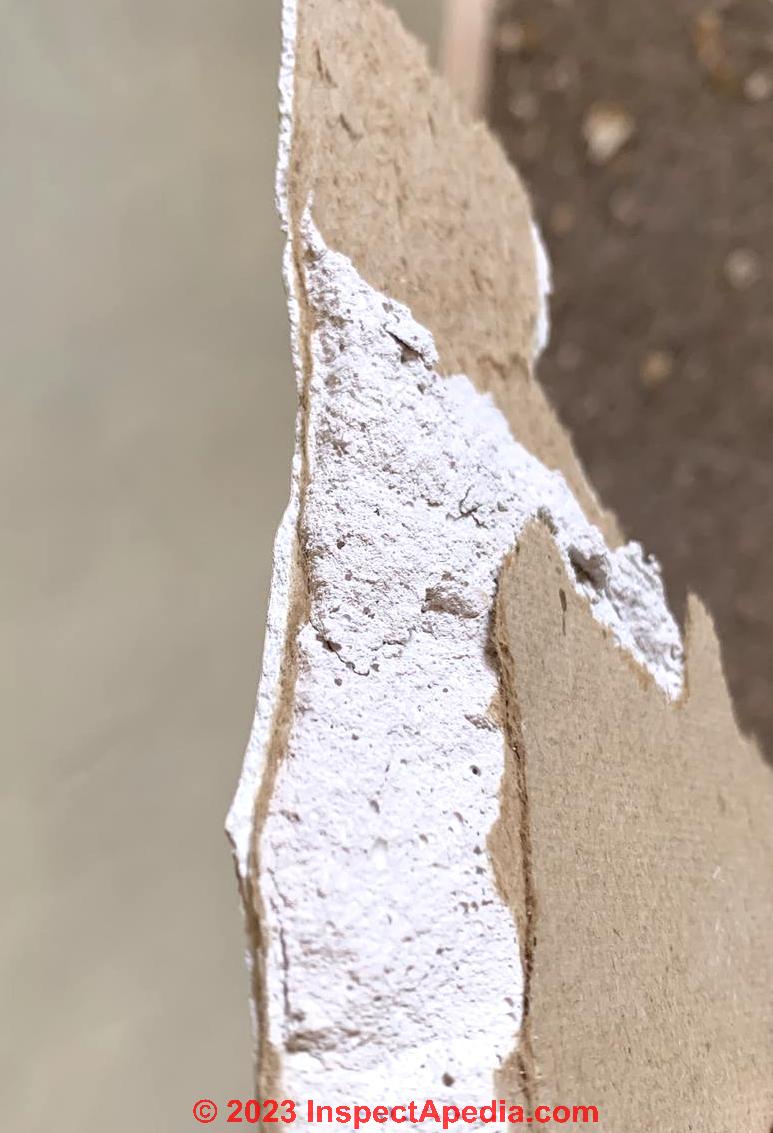
On 2023-12-01 by InspectApedia DF (mod) - does my drywall contain asbestos?
@TH,
You may already realize that we can't tell if drywall or gypsum board asbestos only by looking at the material itself.
End tapes sometimes include patent numbers that give dates, but without that detail the safe approach is to assume that IF your drywall was installed in a building in the U.S. before 1986 at the very least, the joint compound used to finish the drywall can be assumed to contained asbestos.
Don't panic - that's bad for our health and our wallet, but do avoid making a dusty mess, and where there's already some debris or dust, use damp wiping and HEPA vacuuming for the safest cleanup.
On 2023-11-29 by Anonymous - can I replace asbestos-suspect drywall without removing a hot water heating radiator?
is it possible to replace the drywall but keep the original heating radiator in place?
I mean in the case that the raduator is embedded in yhe drywall and just to reolace tge drywall around it
without messing with the pipe?
On 2023-11-29 by InspectApedia Publisher
@Anonymous,
Yes, though depending on how much working space you have you may need to be a bit heavy handed if you're going to pull out the drywall that was behind the radiator, and you may need to use a flat bar to nip off any drywall nails or screws that remain poking out of the studs that remain in place after you've pulled out the drywall itself.
I've done exactly that; I cut away drywall near the radiator, then reached in (down from above or in from sides) to loosen or pop the drywall off of the screws or nails that held it to studs, then torn it out, HEPA vacuumed up the dust, then slid the new drywall into place from above or from one side.It means you probably can't fasten the drywall to the studs unless a stud is right between two radiator sections, but that small area without drywall screws won't be significant.
A radiator that is recessed into a wall normally blocks access to the floor, back, sides, and top of that opening. Pipes feeding the radiator usually come through the floor within that recess but might come from a recess side, back (unusual) or top (unusual).
I don't understand why one could not simply cut off and remove drywall surrounding the opening if we wished to leave the radiator, and its surrounding materials, alone.
Please post some photos (one per comment) so that we can better understand your question.
On 2023-10-28 by Anonymous - is the asbestos type used in drywall and its compound all principally chrysotile?
is the asbestos type used in drywall and its compound all principally chrysotile, i saw mostly were mentioned in only the mud or compound.
so asbestos would only be used in paint and joint compound, not the wall itself? and principally chrysotile? other type of asbesots appeae to be a contamination
On 2023-10-28 by InspectApedia Publisher (mod) - is the asbestos type used in drywall and its compound all principally chrysotile
@Anonymous,
Principally you'll find that references to asbestos in a drywall system focus on asbestos (primarily chrysotile asbestos) that was contained in joint compound or in some paint or spray products such as "popcorn ceiling paint" that may have been sprayed on drywall ceilings.
And about "other types of asbestos are not a concern" , No. Nothing in our research nor our own articles have suggested what you propose.The top of this page we have the following text
If drywall or gypsum board or "Sheetrock®" was installed in your building in North America between the late 1920s and 1980, it is possible that the drywall itself or more-likely the joint compound used on the drywall contains asbestos, primarily chrysotile asbestos.
On 2023-10-30 by Anonymous - is it rare to find amphibole asbestos in the joint compound and drywall itself?
@InspectApedia Publisher, and followed up by less commonly in residential setting.btw, is it rare to find amphibole asbestos in the joint compound and drywallitself? what about ceiling tiles? was chrysotile primarily used?
what do you mean by Modern drywall and taping compound do not contain asbestos. However that was not always the case, as we detail here. is it some years after 1980s may still have drywall with asbestos. is the rensidential use of asbestos banned in drywall after 2000s ?
On 2023-10-30 by InspectApedia DF (mod)
@Anonymous,
The sentence in this page's article "Modern drywall and taping compound do not contain asbestos. However that was not always the case, as we detail here." is explained in the content following that sentence. The use of asbestos in those products prior to the late 1980s is discussed at length. Please do take a look.
On 2023-11-21 by Anonymous
@Anonymous, did you mean that because of the in stock supplies, that even after 1980s there could still be some supplies used before 1990s still contian asbestos
On 2023-11-22 by InspectApedia Publisher
@Anonymous,
Answers to all of your questions are given in detail, along with research citations and expert comments in this article series. Please take a look and let me know if that material is unclear so that we can improve it.
It is very important for you to distinguish between reasonable or significant risk of asbestos hazard versus questions that ask us to give an absolute answer like "never" or "always". The latter is just not possible given the range of human behavior in construction.
On 2023-07-14 by J - possible asbestos in troweled on joint compound or plaster in a swirl pattern?
I live in an apartment complex built between 1950-1960, the ceilings appear to be popcorn but appear to be sprayed on top of troweled plaster or something. I didn't know asbestos was a component of popcorn ceilings until just recently.
In the hallway the ceiling has deteriorated which concerns me even more (picture attached), but in my apartment the ceiling appears to be fine with no visible deterioriation, and it was painted over at least once with an unknown paint, I suspect painted over multiple times since 1960, but right before I moved in it looks like they painted over it again at least, with standard latex wall paint.
There are areas here and there, small holes where it looks like their paint didn't reach.
I'm concerned that the hallway is going to give us cancer, I'm even more concerned that people walking on the floor above me is causing the popcorn ceiling to shed asbestos fibers microscopically, that I'm breathing in daily, are these founded risks? I'm so upset about this I'm considering moving out. Thanks
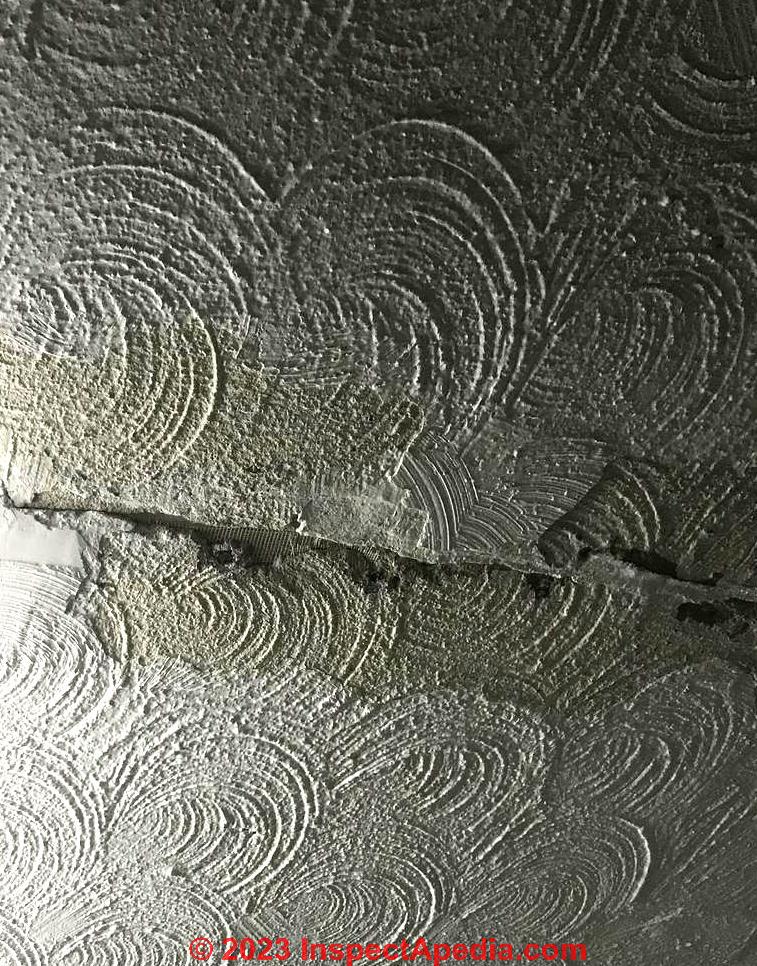
On 2023-07-15 by InspectApedia Publisher - need to test sample to know what remediation may be needed
@J,
Please understand that from a photo one cannot make a reliable guess about how much dust is being sent to the building air and surfaces below, nor whether or not the dust contains asbestos.
A bit of caution is appropriate but real panic is not. The fear can be as serious or more of a health hazard than the dust.
I suggest collecting sample of representative dust from the ceiling and having that examined by an asbestos test lab.
If asbestos dust cleanup is needed you'd have a professional do damp wiping and HEPA vacuuming, and the building manager might want to install new drywall over the existing ceiling.
On 2023-05-09 by Anonymous by private email - Is it safe to drive a picture nail into drywall that may contain asbestos?
I am writing to ask your recommendations for the following situation:
-If there a wall with confirmed asbestos in the drywall "mud" not the drywall itself, is it ok to nail that wall to hang a simple picture?
If so, do any special steps or clean need to be done? thank
On 2023-05-09 by InspectApedia Publisher - safe to drive a picture nail into drywall that may contain asbestos
@Anonymous by private email,
Yes, you can do that.
Thank you for the question, that I'd re-state for other readers as
Is it safe to drive a picture nail into drywall that may contain asbestos?
Consider that typical picture hanging hook nails are very small in diameter. Having hung pictures for many decades, in my opinion and experience, the amount of dust created by tapping in a picture nail is beneath the limits of detection.
In sum, I don't believe there would be a detectable asbestos hazard from simply driving a picture nail into a wall in normal, undamaged condition.
But if you're the least concerned simply use a damp paper towel to wipe up a little dust that falls.
TIP: to avoid any chance of damage to drywall or plaster walls of unknown condition and into which we want to drive a nail, first tape up a bit of adhesive tape, preferably blue, removable masking tape, to the wall over the spot where you're going to drive the nail.
Leave the tape in place, drive the nail, hang the picture. The tape should be covered by the picture and its frame.
Details on how to hang a picture while minimizing dust or wall damage from the nail will be available online along with this Q&A at
PICTURE HANGING TIPS https://inspectapedia.com/interiors/Hang-a-Picture.php
On 2023-03-15 by Anonymous
CGC Canadian Drywall Corporation drywall installed in a 1975 built home on the south shore of Montreal Quebec Canada. Markings on the drywall had dates of 1957 on them. Possibly a patent date. An asbestos test was done and the drywall itself did not contain anything however the drywall compound did. I’ve attached the results of the test.
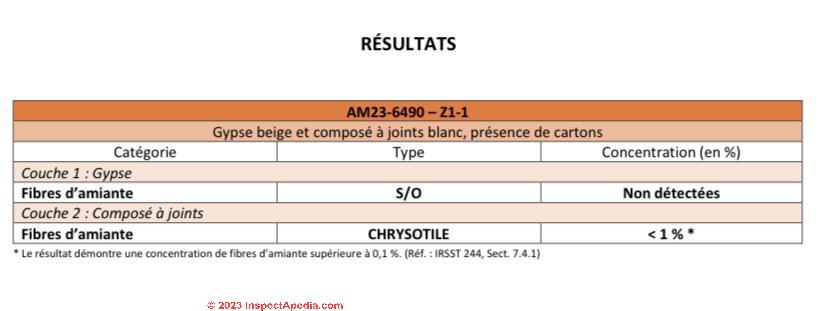
On 2023-03-15 by InspectApedia Publisher - CGC Canadian Drywall Corporation drywall installed in a 1975 test results for asbestos
@Anonymous,
Thank you that's a very helpful contribution.
If you can post photos of the Identification stamps on the drywall, that would also be very helpful to keep with this report.
On 2023-01-23 by May - risk of asbestos in drywall in a 1951 Michigan home
1951 house in Michigan. All interior walls are harder than new chalky dry wall. Comes in sheets covered on both sides by brown paper/cardboard with a white layer in between. Then entire surface is covered by gray layer that looks like cement. No fibers.
It Is very hard and crumbles when it is cut or drilled into. One room has coved ceiling.? wet plaster. What is this? And how do I cut it? The edges crumble into chunks and can't even get close to straight.
On 2023-01-24 by InspectApedia Publisher
@May,
It sounds as if you are discussing a later generation of plaster that used a gypsum board as the base instead of wood lath or metal lath. Some people call it rock lath.
If you use it our page Search Box to search for that phrase you'll find a description of the gypsum board lath / rock lath product and its history.
On 2022-11-25 by S - spray a binder glue onto drywall before drilling into asbestos-suspect drywall?
I have a house built in the 50s. I have no idea if there could be asbestos in the drywall or cement/plaster walls, but understand it is of course possible.
For things like drilling into the wall to hang curtain rods, would spraying an asbestos binder first before the drilling help to keep me safe if there is asbestos? I saw this on Amazon
Fiberlock ABC 6410 Fiber SprayAirless Fiber Spray- 8 oz Can
On 2022-11-25 by InspectApedia (Editor) - Safe drilling into asbestos-containing drywall?
@S,
Safe drilling into asbestos-containing drywall ?
Thank you, that's a helpful question.
In my opinion, there is almost no value whatsoever spraying the surface of drywall with an asbestos encapsulant or binder paint before cutting or drilling into the drywall or gypsum board itself.
Consider that the spray coating will be ONLY on the SURFACE of the drywall.
The moment your drill penetrates the layer of paint and paper covering and forming the skin of the gypsum board it's now drilling into the gypsum core of the board and producing a bit of ground up drywall board core material that comes out around the drill bit.
The paint is not going to do anything helpful and in my view that was not the purpose of that paint in the first place.
What you can do to minimize dust fall-out or distribution when drilling into drywall to hang curtain rods are the following
1. use a sharp drill bit that is no larger than necessary. Often a screw can be turned into drywall with little or no pre-drilling so very little dust will be produced
2. if you must drill, run the drill slowly so as to cut cleanly and to distribute dust as little as possible
3. Place a drop cloth or plastic below the drilling location to catch the dust and ease clean-up
4. For larger drilling or cutting operations, an optional step that is very effective is to use a HEPA-rated vaccuum cleaner to catch and draw-in dust from drilling or cutting while the drilling or cutting is in process. Hold the vacuum intake nozzle as close as is safe to the cutting operation and just below the cut or drill point in the wall or ceiling.
5. Clean up any missed dust on nearby surfaces using damp wiping and HEPA vacuuming
On 2022-09-28 by Bobby Fitzgerald - how much asbestos risk from a small hole in 1963 era drywall?
Good Day,
About a year ago I purchased a home that was built in 1963. I have read some articles on how joint compound or even drywall or plaster itself could contain asbestos.
I found a hole in the wall that we saw after moving a piece of furniture around and I’m concerned that there could be asbestos. It’s a difficult picture but it’s a wall that connects the living room to the garage.
This is a very small hole and I’m hopeful that even if there was asbestos detected that it would not be large enough to create a hazard. We have small children and that is the concern.
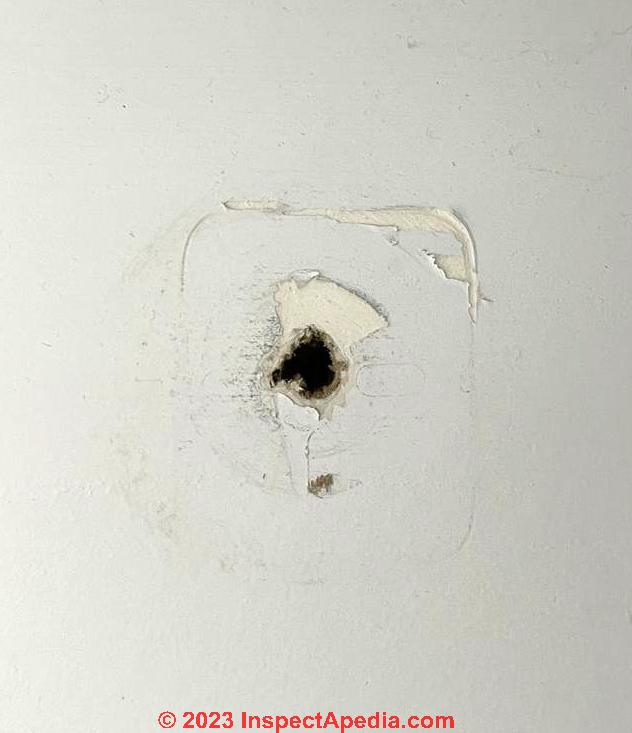
On 2022-05-07 by Inspectapedia Com Moderator
@Bobby
Hand-turning a screw into drywall will release less dust than drilling, in my experience, but neither of those singular tasks is going to produce a significant amount of dust. Damp wipe, HEPA vac, or your methods sound perfectly reasonable.
On 2022-09-28 by InspectApedia-911 (mod) - single small hole in drywall would not be a meaningful risk
@Bobby Fitzgerald,
I agree with you that a single small hole in drywall would not be a meaningful risk in a building even if there happens to be asbestos in the drywall or the joint compound.
Also, you might put your mind more at ease by simply taping Over the Hole.
Asbestos Use in Drywall Joint Tape?
We have moved this discussion to
Research Documenting the Asbestos Content in Joint Compound & Gypsum Board or Drywall Finish Systems
This research listing has been moved to
ASBESTOS RESEARCH ON DRYWALL FINISH SYSTEMS
Bestwall Drywall Asbestos
This topic has moved to BESTWALL DRYWALL ASBESTOS
Does Canadian CGC Drywall contain asbestos
Now found at ASBESTOS in CANADIAN DRYWALL
Drywall & Joint Compound Asbestos Remediation - How to Cover or Remove Asbestos-Containing Drywall or Joint Compound
This discussion has moved to ASBESTOS-DRYWALL REMEDIATION / REMOVAL
Watch out: do not disturb asbestos-suspect drywall materials; it's generally safest to leave such materials alone or to cover them. If demolition or removal is required, then the additional steps discussed here are pertinent.
Identify Certainteed Asbestos-Containing Drywall or Plasterboard
This discussion moved to
...
Continue reading at ASBESTOS in DRYWALL MUD - TEST LOCATIONS or select a topic from the closely-related articles below, or see the complete ARTICLE INDEX.
Or see ASBESTOS in DRYWALL FAQs - questions & answers posted originally at the end of this article.
Or see these
Recommended Articles
- ASBESTOS CEMENT CEILING & WALL PANELS
- ASBESTOS in DRYWALL
- ASBESTOS RESEARCH ON DRYWALL FINISH SYSTEMS
- BESTWALL DRYWALL ASBESTOS
- CANADIAN DRYWALL ASBESTOS
- CANADIAN GYPSUM LIME & ALABASTINE GLA DRYWALL ASBESTOS?
- CELOTEX DRYWALL ASBESTOS
- CERTAINTEED DRYWALL ASBESTOS
- CGC GYPROC DRYWALL ASBESTOS?
- COATING TYPE CEILING & WALL SURFACES: CATALOG OF
- DOMTAR GYPROC ASBESTOS?
- DRYWALL & GYPSUM BOARD COMPOSITION & HISTORY
- DRYWALL TYPE IDENTIFICATION STAMPS
- GENSTAR GYPSUM LTD ASBESTOS?
- GYPSUM BOARD GYP ROCK SHEATHING
- GYPSUM BOARD PLASTER LATH SYSTEMS
- IGNIFUGE GYPSUM BOARD ASBESTOS?
- NATIONAL GYPSUM DRYWALL ASBESTOS?
- PICTURE HANGING NAILS to avoid damage/dust
- PLASTER TYPES & METHODS in BUILDINGS
- US GYPSUM SHEETROCK ASBESTOS
- SHEATHING, GYPSUM BOARD
- ASBESTOS in DRYWALL MUD - TEST LOCATIONS
- ASBESTOS in DRYWALL TAPE?
- ASBESTOS-DRYWALL REMEDIATION / REMOVAL
- ASBESTOS in PLASTER - what about the use of asbestos in plaster walls & ceilings?
- ASBESTOS PRODUCING COMPANIES & TRUSTS - complete list includes all asbestos-containing drywall producing companies
Suggested citation for this web page
ASBESTOS in DRYWALL at InspectApedia.com - online encyclopedia of building & environmental inspection, testing, diagnosis, repair, & problem prevention advice.
Or see this
INDEX to RELATED ARTICLES: ARTICLE INDEX to ASBESTOS HAZARDS
Or use the SEARCH BOX found below to Ask a Question or Search InspectApedia
Ask a Question or Search InspectApedia
Try the search box just below, or if you prefer, post a question or comment in the Comments box below and we will respond promptly.
Search the InspectApedia website
Note: appearance of your Comment below may be delayed: if your comment contains an image, photograph, web link, or text that looks to the software as if it might be a web link, your posting will appear after it has been approved by a moderator. Apologies for the delay.
Only one image can be added per comment but you can post as many comments, and therefore images, as you like.
You will not receive a notification when a response to your question has been posted.
Please bookmark this page to make it easy for you to check back for our response.
IF above you see "Comment Form is loading comments..." then COMMENT BOX - countable.ca / bawkbox.com IS NOT WORKING.
In any case you are welcome to send an email directly to us at InspectApedia.com at editor@inspectApedia.com
We'll reply to you directly. Please help us help you by noting, in your email, the URL of the InspectApedia page where you wanted to comment.
Citations & References
In addition to any citations in the article above, a full list is available on request.
- In addition to citations & references found in this article, see the research citations given at the end of the related articles found at our suggested
CONTINUE READING or RECOMMENDED ARTICLES.
- Carson, Dunlop & Associates Ltd., 120 Carlton Street Suite 407, Toronto ON M5A 4K2. Tel: (416) 964-9415 1-800-268-7070 Email: info@carsondunlop.com. Alan Carson is a past president of ASHI, the American Society of Home Inspectors.
Thanks to Alan Carson and Bob Dunlop, for permission for InspectAPedia to use text excerpts from The HOME REFERENCE BOOK - the Encyclopedia of Homes and to use illustrations from The ILLUSTRATED HOME .
Carson Dunlop Associates provides extensive home inspection education and report writing material. In gratitude we provide links to tsome Carson Dunlop Associates products and services.


